#Single-cell Data Visualization
Explore tagged Tumblr posts
Text
0 notes
Text
General realizations ab shifting that helped me
The void is not a realm or a place- it is YOU. You ARE the Void. The Void is solely the awareness of being, fully.
You are not ONE being. Think of the consciousness in you as being interconnected with all other infinite versions of you. These interconnections converge into your full consciousness, the true YOU. It's almost Eldritch to think about.
Something I'm just now thinking of, perhaps this means the subconscious is all other versions of you- you're separated and cut off from experiencing the entirety of being, but that entirety is still there, guiding you from behind the scenes.
No matter what the assumption, "I am" is true. I am kind, as my actions and thoughts show, but I'm also cruel and cold-hearted, as may be the perception of another. I think I'm funny, but someone else may think I'm cheesy- therefore, I am both. And this also goes for the personas of myself in other realities. I am everything. Simultaneously, this also means I am Nothing. I simply am.
To add to the points above, I believe this "Eldritch" conglomerate is what we call the Void state, and would explain why every manifestation happens instantly once we reach this state. Think of it like accessing the files in an infinite data base- all you need to do is find the files you're looking for and download them.
As much as people will try to stress things like "you need to let go" or realizing that shifting is easy, you won't truly be able to understand what they're saying until you experience it.
All things exist at once and every inconceivably small action creates a new reality. As small as "this single cell from 7000 years ago died .000000001 seconds prematurely", and smaller.
Shifting IS easy- in the same way that gleeking or stretching is easy. Some people are able to do it on command or go further than others with no training whatsoever. Others may do it accidentally and sporadically. This does not mean the latter are unable to do these things at will, but they simply need a bit of help learning to do it on command.
Question stressing you out? "But what about this plot hole?", "How does XYZ work??", "What will happen back in my OR???"- STOP. No need to stress yourself over that, this by itself I feel cost me years on my journey. Everything will work out. It doesn't matter how, but it will, and it will either even itself out or be in your favor. Don't even think about those things. Relax.
Another one that held me back MASSIVELY. Struggling to visualize your DR? "I know it has THIS SPECIFIC TABLE in this SPECIFIC place and everything has to be perfect"! No. Your visualization does Not need to be perfect. Nor does it have to be "accurate", really. Once you just let your mind wander and let your subconscious make up it's own layout, it'll help you slip in much more easily. I put so much pressure on myself to make sure I was visualizing my specific reality, and it became so much easier when I just trusted myself to build it up from my subconscious instead of "forcing" a look
They say once it's in the 4D (imagination), it's already real. That's why you're encouraged to embody, think, act, feel as your DR self. Like playing pretend as a kid, you'll be so focused on your imagination, you don't even realize you're in your OR. If you don't shift through that alone, it certainly helps make you feel far more connected. This is also why I came up with the Furina method (although I suppose it's debatable if I really "came up" with it)
Methods/Advice are like pants. Some are too itchy, some are too tight, some you like the feel of but there's just some small flaw. When you find what you were missing, what you needed to hear, it'll be a perfect fit.
#reality shifting#shiftblr#shifting community#shifting#shifting blog#desired reality#shifting motivation#shifting realities#shifters#shifting consciousness#void state#the void state#the void#loablr#loa#loa advice#loass#loassumption#this kinda just turned into me yapping lol#will edit#java jots
2K notes
·
View notes
Text
every single thing involving a computer is designed to put something into our senses. until a human looks at it, and interprets it, it is nothing. it isn't 'data'. it isn't 'ones and zeroes'. it's just some electrons and photons moving around, as is their wont.
but if we arrange those electrons just so, and let them do their thing, we can create a pattern that someone will experience as bits, registers, numbers, letters, instructions, algorithms, messages, financial transactions, videos, thoughts, worlds, etc etc.
the whole project of computer programming is corraling the electrons into situations where they will obey rules we have in our heads. electrons are surprisingly predictable, so this isn't a fool's errand. but every layer of the stack of abstractions is something we built: arranging one thing to produce a pattern we want to see. the chip arranged so the 'high and low voltages' fit our idea of 'bits' and 'logic gates'. the screen whose lights create a 'field of colour' for an organism that has this level of visual acuity, this frequency response in its cone cells, this capacity to see shapes and edges. these bits and logic organised into an 'algorithm' that takes 'data' that we think of as 'vertices' and 'triangles' and produces the appearance of 'perspective rendering', which approximates our concept of a '3D object', of even a 'virtual world'.
we have gotten so very very good at producing these patterns that it's easy to see them as something natural, and miss all the layers of orchestration behind even the simplest operation. computers are a game played between humans.
661 notes
·
View notes
Note
hey..
at what point do collectors opt to turn things from puppets to scrolls? I feel like turning an entire living creature into [a piece of paper] is very complicated, while turning them into simple puppets is easier because they keep all the same parts, just simplified and wood?
It is! It depends on the person's proficiency and understanding of the mechanism regarding when and how they change the creature. Once someone gets good at it, the creature can be transformed into a lifeless object without it dying in the process, and they will move on to more complex and efficient ways.
The way I see it, archiving is a form of information compression and storage—and there is A LOT of information. When looking at Earth creatures we have everything from single-cell bacteria to whales that range up to 100 quadrillion cells, all with different sizes. The smallest single-cell critter is 0.3 μm, while the largest single cell is an ostrich egg that can get to 18 cm. So it's not just noting "a cell"—there's also a lot of information about the cell content, size, the DNA, current water, and oxygen levels, what protein it contains and how much. Then there are spatial dimensions. (While we can consider there being more, especially in fiction, I’m sticking to three; trying to visualize four fills me with frustration and existential dread xD) Every cell has its place in space in relation to the others, and all the contents' relations are also important. If, suddenly, all histones materialize inside a mitochondria instead of the nucleus, we can have a problem. Additionally, physical and chemical processes gotta be considered. There's electricity powering our brains, hearts, running nerves, air in airways traveling to lungs, chemical signals traveling between synapses that also need to be accounted for. So, you have all the contents in space, their vectors, and building blocks. Thats a ton to save. This information has to be compressed to be preserved in an organized manner while also remaining lossless so that when returned to its original shape, it's as it was. Not even mentioning that in intelligent beings, there are also minds to take care of. Jellyfish might be fine after 100 years in a static void, but a human? Yhhhhh.
I think the mechanism would work by saving information in intangible magic and assigning it to a physical medium—be it a statue, doll, book, or scroll. If it is physical and can carry information, it can be used. We can argue the mind is part of the soul, or it is a biochemical process, but the fact is nobody really knows for sure what it is and Im not a theolog, so for the sake of this universe, I'll say it's something that occupies the same space magic does and is influenced by chemical processes, meeeeaning it can also be tricked by them. And the magic.
The first degree of preservation would be spells that only change the material but keep all shapes and info in place. This wouldn't require much thought while executing and could be "automated" or worse, taught to mortals (if they have enough magic to power the spell), like petrification or changing someone into wood, metal, or any other solid material. It's not perfect, if the structure is damaged, the spatial information is damaged too. Breaking is one thing, but imagine if the statue melts.
The next step would be assigning objects with some compression and change, like toys and dolls. I feel like there would need to be a system like a content library, so not every single atom is saved each time, but chemical structures like nucleotides in DNA (the ATGC thingies) would just have a shortcut. Larger repeating patterns could also be assigned their own id to save data, and it would slowly stack up. While things are written in intangible magic form and anchored to the medium, the medium can be somewhat customized, like the decorations the Collector added to the dolls. The mind, running in controlled magic, can also be affected, as we saw with Collie trying to scare them and Luz’s dream. On the spell keeping the preserved critter stable has a link to what shortcut it uses so with countless diffrent worlds and structres it wouldnt mix up.
Then we go further into compression, reducing size and dimensions until we reach a point where one axis is almost entirely removed, and we end up with a scroll. Then there are other things—creatures saved as amber miniatures, snow globes, scrolls, or drawings, sometimes purely to annoy the sibling that has to deal with the creature in unhandy form. A more permanent binding would be in a book that can contain a bunch of different animals. Rebinding for long-term preservation is the Curator’s job.
Looking at Earth creatures, eucariotic life shares ancestry with some ancient bacteria that decided to rebel and started to cooperate, so we share similarities even with distant organisms in some strutures since they come from each other. So when it comes to preserving whole populations with relations, the library of compression doesn’t have to be separate for every single animal or plant. For each section of the archive, there would be a common library of building blocks, and scrolls being somewhat separate carrying the exact instructions for body arrangement and the soul/mind/the part that makes them alive attached.
Next is unpacking the information. I think this requires the ability to interpret and recreate what was saved that mortals lack. While they couldn't really unpetrify others, a collector could (assuming the mind hadn’t deteriorated into a husk). In the case of an automated spell, I think it would result in a very lossy transmutation—like a jpg losing pixels, the creature might lose like heart funtion. The Collector's spell also looked temporary or incomplete since an influx of other types of magic (like in Amity or Raine’s case) was able to push back on it. That might also be why they were conscious in the form they were in. Not meant for long just enough to take them to archive in normal conditions. When a creature is heavily compressed, it needs external force to rebuild, as it's essentially written fully in magic. That’s what I think happened to the Owl Beast. Lilith released it from the medium, but since it wasn’t fully rebuilt, it being a magic form attached itself to a magic source.
SO YEAH, its a process that takes quite a while for them to master and it comes with experience. But when experience is based on life it often makes it hard to practice so those with less empathetic approach master it faster. Thanks for the ask! I was dying to talk about that for such a long time and that was a perfect thing to organise thoughts
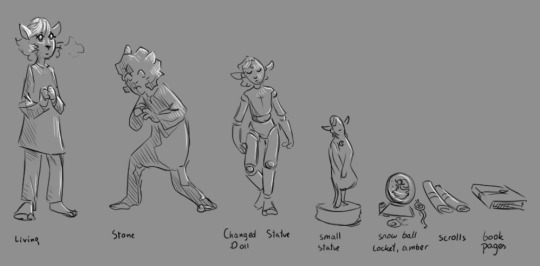
#and consider the absolute body horror that is transmutation#imagine how it has to feel on the border of skin that is being turned to stone when nerve endings cant send what is happening#but can send the numbness of “there is something super wrong” like in severe frostbite#both must feel like tissue dying#tw body horror#i did not use that one in a moment#In the begining i had a concept that it all saves the same way like a doll so diffrent archivists would have diffrent methods#like Anatomist using scrolls Wayfarer drawings and so on but then realised that would be super unhandy when a book carries more info#and its easier to fix a doll than a scroll so settled on this#thats also why in the comic where Way damaged creature they were turned into a doll Way was just very unexperienced with archiving spells#Collection Incomplete au#the owl house#owl house#toh#the collector#toh collector#toh archivists#the archivists#toh collectors#ask#i took sleeping meds before writing this safe to say they didnt work
60 notes
·
View notes
Text
The Best Thing I Added to My Notes
Daily Blogs 359 - Oct 29th, 12.024
This is probably the best thing I added to my daily notes.

What?
This is a routine heatmap. The simple explanation is that is shows how many tasks related to my routine I have done in that day, the brighter, the more tasks.
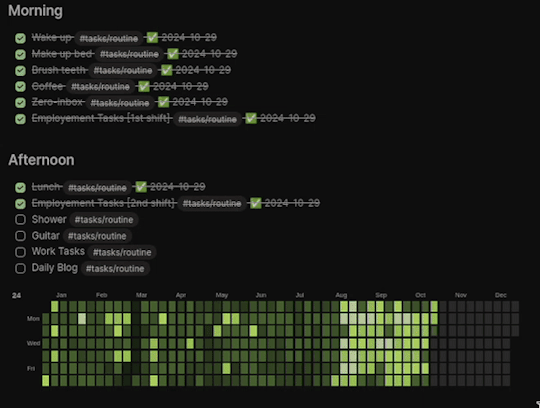
Why?
One of the things that I found is that I'm very easily insecure about myself. Even if I'm doing fine and working on the things that I like, I still have days when I almost forget everything and start doubting myself over and over thinking that I'm not doing enough. This situation happened to me a lot over the previous year, and because of the amount of pressure I placed in myself in these attacks, I started to just feel demotivated and started to stagnate. I never could really prove to myself.
And then I found about this concept, I don't know where or when necessarily, but it was about having data to prove to your own brain that you are supposed to be fine, have palpable methods to convince yourself. Not only having proof, but also, having constant feedback if you are doing fine or if you need to actually question and do a course correction.
This map, this calendar, is what proves to myself that I'm doing fine and that I am improving. Every single day I look into it since it is on my daily notes, and I can see if there are any worries or not, there's no reason anymore to doubt myself as much. Even tho not all days are the brightness, mostly because they are based on the current amount of tasks of the current routine, I can't say to myself that I'm not trying. If any of these days there is a strange black void, I can just click into it, and go back memory lane to remember.
Also, the instant feedback is great. Since I know how the brightness is calculated and that it cares about the percentage of tasks of the current routine, I don't really care that much about older cells, but I do care if some pattern start to arrive in the recent ones. Like the stripe in the first quarter of the year, when I was helping my family and wasn't able to work that much, and the brightness of the last half of the year, when I got a job and organized better my work.
And as a bonus, this map also helps me know where I am in the year. Since I do Quarterly Themes, somewhat aligned with the year seasons, having a visual clue to know what quarter I am, even more when the seasons don't affect that much the look of the ambient outside home, really helps. This clue is not only via the amount of days that passed in the calendar, but also it's color:
Red for summer, quarter one:

Red for autumn, quarter two:

Blue for winter, quarter three:

Green for spring, quarter four:

How?
I don't really know how much it is possible in other note-taking apps, but in Obisdian is kinda simple if you know a little about scripting. It uses just two plugins: Obsidian Dataview and Heatmap Calendar for Obsidian. The Dataview script used is this:

In summary, the steps are:
Get all daily notes of this year (The year value is added via the file template);
Loop over all daily notes:
Get all completed tasks of note;
Calculate the percentage of completed tasks;
Push the day entry to the calendar data, with the correct color (The value "season-spring" is put by the template).
Render the Heatmap Calendar using the function provided by the plugin.
The source code of the daily note template is available on my vault template repository.
Today's artists & creative things Music: I Gave Everything - by Connor Price
© 2024 Gustavo "Guz" L. de Mello. Licensed under CC BY-SA 4.0
20 notes
·
View notes
Text
Day 22 (1/2)
Stone's Echo

I left the village before dawn, restless. First, to Larend's salvage camp, after that, who knows. I can't roam this stretch of land forever. The number of problems for me to solve for the people here will only grow, exponentially, until everything dies.


Turning eastward, I returned to the ancient killing field I'd passed weeks prior, riding under the arms of Titans, choked with greenery. Burrowers patrolled, watching over sparse herds of Chargers.

As the sun rose, I arrived at Larend's camp, smoke rising in a single scant plume behind a ramshackle wooden fence.

As the orange light of morning fell across the camp, I handed the Shellwalker plating over to Larend and collected payment due. He was still in need of the parts after all. Not many hunters for hire were willing to cross these regions for shards alone, given the presence of Regalla's rebels and the Apex machines appearing across the lands. So, it wasn't just Cauldron Tau—Hephaestus has been at work in Cauldrons all across the lands, maybe the world. Brilliant. At least I've dealt with the rebels in the area now.

On a circuitous route back west, I checked out some old military ruins overlooking the battle field.
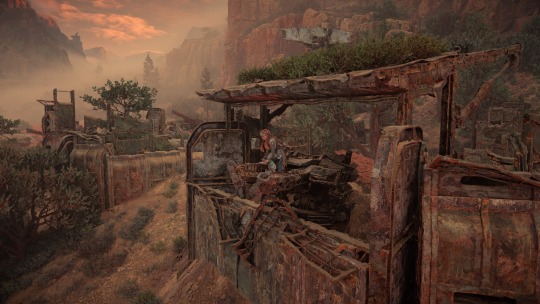
Unsurprisingly, the Oseram traders had picked through the place already, and there wasn't much in the way of salvage left behind. There were datapoints, though—scraps of military orders, personal memos, dying words. I tried to picture the valley below devoid of life, a burning pit of bots, rolling up toward the compound in a wave of black metal and bio-mist. Then I wished I hadn't.


Further on, back on the valley floor, I returned to the ruins I'd passed on my first ride west, where I'd saved a few delvers from a band of rebels. The delvers had evidently moved on, but now equipped with my ignighter, I'd be able to blast my way through the Firegleam deposits dotting the ruin's sealed walls.
I did just that, though the crystals burned quick and hot, and I couldn't get away in time to avoid the barrage of stones that followed detonation. Barely missed my dumb skull. I have to be more careful.

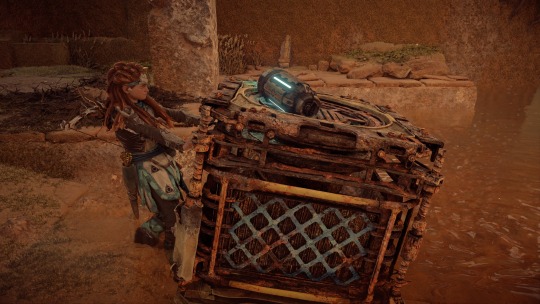
Inside, my Focus picked up an artefact behind a locked door across a broken walkway. It was a projector of some kind; powerful, packed with visual data, but not much else. Curious, I engineered a way across.
With a little more blasting, I found a datapoint with the code for the locked door, and an empty power cell to bring the mechanism back to life. Once charged, I couldn't walk the cell across the flooded portion of the room—the ensuing electric blast rattled my bones. The years had made the machine volatile, and I needed to drag it across on top of a handy crate to keep it out of the damp.

Entering the code and opening the door, I was able to examine the ornament more closely. Projections of bright yellow leaves emanated from the sphere, powered by an internal source across the intervening centuries. Impressive, but I have no idea what greater machine it was made to slot into. Still, all that whirs is of value to the Oseram. I might find a good price for it or, better yet, find out its true function and return it to service.
I took the sphere with me when I left, tying it to my mount.

I passed back through the battle field, now heading west. I scanned the rebel camps I'd cleared when I first crossed the border, checking for any sign of resumed activity. Nothing. With my efforts, I've managed to drive the rebels out of No Man's Land and most of Utaru lands too. Not bad, but I have a feeling their true might is hidden across the mountains in Tenakth territory.


Crossing back into Utaru lands, I headed north toward Plainsong, wanting to check that Yef and the other Eclipse prisoners had made it back home safely.
On the way, I spotted large Utaru structures in an uncultivated area—a village lost to the wilds in the aggression of new machines. Skydrifters patrolled the village skies, including two Apex variants. I figured I could do the Utaru a favour and clear out the pests, though I mainly wanted to study Hephaestus' new experiments.

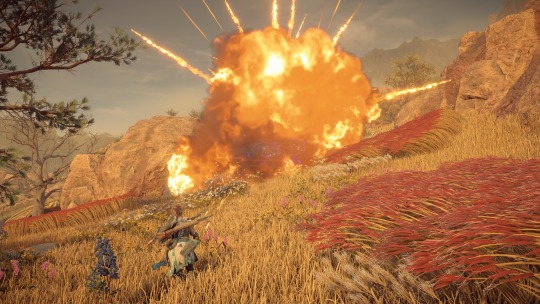
The black-armoured Skydrifters were stocked with acid canisters in place of their usual shock coils. An acid arrow to each on the first; spear strike, then hardpoint arrows to the corroded armour. I kept the other Skydrifters off me with coil detonations and my Ropecaster.
Once the first was down, I picked away at the final two machines, keeping away from their flaming tail whips and waves of long-range, little mines with my Pullcaster, latching onto the old village structures. My Spikethrower came in useful too.
Finally downed them all, the herd of Fanghorns long since spooked off into a nearby copse. Good haul, and good data scraped from Hephaestus' machines. Hopefully Gaia can make use of it.

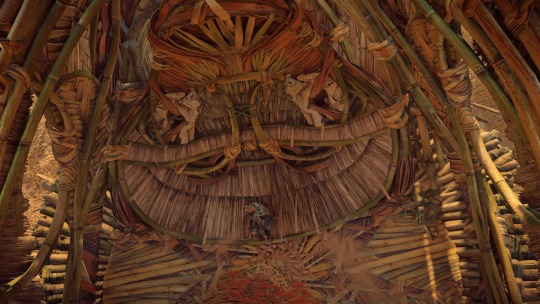
The village altar, tilted, the floor rumpled by up-shooting grasses breaking through the weave. It must have been even more beautiful when inhabited. I hope the Utaru can return here someday.


I rode the short way remaining, making it to Plainsong in the afternoon. Things are seeming a lot calmer now with the nearby rebels driven out and the forces of Hephaestus stopped at their nearest source, if not entirely.

Working the fields, I found Emboh. He told me that Jaxx had returned a couple of days prior with a Tenakth youth in tow, and thanked me for searching for his friend. It was good to hear that the Chorus had allowed Korreh to stay in Plainsong, but by the look of the dead, blighted crops Emboh was attempting to revive, the city might not be a safe place for the youth much longer.

Sure enough, I found Jaxx and Korreh near the city entrance. Korreh had passed the days since his arrival learning to play an Utaru instrument, similar to that carried by Kalae on her pilgrimage. The music was beautiful—deep, earthy, reedy drones, dry winds and deep rumbles. He was utterly transfixed on the music, and Jaxx seemed proud of how quickly he'd adjusted to his new life. I only hope it'll be a long one and that, someday, the Tenakth might learn to value their infirm enough to let him feel the air of his clanlands again.
On my way through, I dropped my Utaru garb off with Gana for a fresh coat of dye, choosing more muted colours suited to desert camouflage. Whether news comes from Gaia or not, I need to head west to seek out the rest of Regalla's rebels and unravel Sylens' mysterious plot before he can do any more damage to the people of these lands.


I found Yef with a group of fellow former slaves sitting by Daen's kitchen. Yef had taken the lead, first in the way back home, and now in the care of his injured people. I could tell he was restless, meant more for a life of exploration and daring feats than tribal rites and bed rest, but life in Eclipse clutches had shaken him, and he was glad now just to breathe and to tend to the scars of body and mind left on their captives.
I shared a meal with the ex-captives, offering as clear answers as they would understand about the Eclipse and their motives, for those who wanted to know. For most, it was enough to know that they were Carja and came to these lands to do as Carja have always done. I didn't press my point.

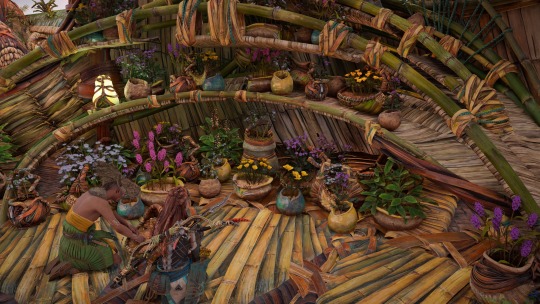
At the altar, I found Bree. He was planting Kalae's seeds in a basket to sit amongst the other offerings. She was never permitted the chance to speak on this stage as part of the Chorus, and instead would watch from behind, silent with the rest of the blooms of the dead, but it was not all despair. Despite Bree's rage at the corruption that gripped the Chorus, he had continued spreading Kalae's ideas, along with the truth of Kel's shortsighted brutality.


A few more hours spent in the golden light of evening, waiting for Gana's work to be done. One of the Utaru waved me over and offered to paint my face in the style of a Thresher, a symbol of strength and perseverance. Why not?

I need to move on. With the rebels driven out and the flow of Hephaestus' machines stemmed, the Utaru's most pressing problem is starvation. Only repairing Gaia will resolve it. West next, to get to the bottom of Sylens' plans. Until Gaia calls me to action, I'll do what I've always done best: right wrongs, and kill killers.
4 notes
·
View notes
Text

Medical PTSD be like...
Yeah, I'm still trying pretty hard not to beat myself up too much over a "bad' day yesterday.

With the 24-hour graph at the bottom. Those single red dots over to the far right were recalibration readings, because this sensor was actually running a little low before that. (Partial explanation for the red supposed hypoglycemia line while I was asleep. Found out that xDrip+'s alarms are very effective at waking me up! 😒)
What happened there? An awful lot of pasta, plus some misestimation of how much insulin it needed to cover it. Then some borderline "rage bolusing" as the numbers kept climbing.
That really is not a bad day at all by a lot of other T1 standards. The usual professional goal to aim for is 70% time in range or more. That 24-hour prriod still exceeded that. But, being wound too tight? Mine has been averaging around 99%, with mostly the occasional mild brief high.
With some backup, my pancreas is apparently still squeezing out a tiny amount of its own insulin in response to food--which probably helps too even if it's not so predictable. Those final few beta cells may well have been on strike last night. ¯\_(��)_/¯

The past week visualized. Where the white line is median levels, the more solid blue is the range it's stayed in 75% of the time. The lower dips during my night owl "overnight" are mostly from lying on the sensor funny, which is a very common way of getting false lows that bounce right back up after you move. (The other part of the equation with that red line earlier. I lay in a bad position for hours straight.)
Anyway, the more transparent blue is an outlier and should not be counted--or so I keep telling myself. That was HEAVILY affected by last night's pasta oopsie.
Guess I'm not actually doing too bad when that's the highest I've gone under my own power over the past several years since I got a CGM.
(They have done at least that bad with the IV glucose a couple of times during procedures, but I had fuck all control over that. What with being knocked out unconscious, and also a couple of hospital floors away from my insulin at the time.)
I do try to keep this in mind, and also take glucose readings as data points to learn from rather than hanging personal value judgments on them. [Strictly rhetorical] Lord, do I try. It ain't always easy, and it really doesn't help when you're feeling physically hungover from a rollercoaster. That can make it easier for some unhelpful mental scripts to start up.
9 notes
·
View notes
Text
Space, Mind, and Void: Getting to Know Your Neighbors
Let's talk more about Space for a moment. (Can you tell I'm a little fixated on this Aspect right now?) Space is not just the Aspect of creation, visual arts, and literal space. It's also represented by the classical element of Water. (There are people out there who will tell you that Space is actually Earth, and Blood is Water. These people are wrong.) Space is "concerned with the big picture," sure, but what does that really mean? Strap in, because we're going to get a little bit ~conceptual.~ This Aspect is vast, essentially containing everything that is.

If we look at its neighbors, Mind and Void, we can understand Space as their intersection. The universe is not a "conscious" entity in a way we as humans can relate to. After all, it is a frog. If you take the instinct of self-propagation and expand it out into a literal universe-sized organism, its methods of attaining that feat would look a lot like conscious choices from someone on our level of complexity, wouldn't they? Ask yourself this: does a person consciously tell their bodies to produce new cells? What about the reproductive cells responsible for new life? There are forces within the universe that have their own desires—and the players themselves are invaluable, as their cooperation and success provide the only way that a universe can propagate—but the Genesis Frog simply is.
The Genesis Frog "contains every single instance of the universe that is within him," which naturally includes every choice one could make. Unlike Mind, however, Space itself is largely unconcerned with causality. It is merely the stage upon which the play is set. So, Space and Mind aren't the same thing. Why, then, are they neighbors? Put simply, the domain of Mind is not restricted to the choices one makes. Mind is what allows us to conceive. It's what allows me to find patterns and relationships in Homestuck's cosmology and Classpect system, just as it allows you to come up with your own interpretations of the same. Concepts, ideas, philosophies—these belong to Mind. The intersection of Space and Mind is, quite literally, the galaxy brain meme. Space provides the backdrop, but Mind invites you to imagine, to engage with possibilities as limitless as the universe itself. Mind brings you to a million crossroads and asks one simple question:
What will you do?
Let's take a look at our neighbor on the other side: Void. This Aspect is also characterized by its breadth. Much like a dark and impenetrable ocean, those who flirt with the Void without a proper appreciation for its nature may find themselves sinking helplessly below the surface. A Hero of Space may have difficulty teasing out their purpose in the game, chewing on the grand mythology their Land offers them free of charge. Nevertheless, the writing is often already on the wall. A Hero of Void, however, will find that their purpose has been translated through dozens of foreign tongues, with plenty of key information lost to time—or purposefully redacted. The result is a riddle wrapped in a mystery inside an enigma, pocked with uncertainty and doubt. Whereas Mind encourages its players to parse through a vast array of known options to find a way forward, Void demands that its players conceive the inconceivable, creating something from nothing through methods best described as arcane.
There are two kinds of people in this world.
1. Those who can extrapolate from incomplete data
Space and Void both share a profound connection to Water, and they both possess a certain vastness that can only be truly understood through experience. These are both true of Mind as well, though Mind's connection to Water is much more abstract. (Appropriate, considering Mind sits above the Aspect Wheel's horizon, in the World of Ideas, while Void sits below, in the World of Matter.) Yet, they all deal with a theme I've mentioned several times now: conception. Birth. The new replacing the old. Space and Void both conjure up a sense of creation that's almost miraculous in nature. To create a whole universe, even for the most powerful Space player, is still incredibly impressive. To create something from nothing—whether that "something" is a physical object, an idea, or a secret third thing—is no less astonishing. A Mind player can synthesize information, make inferences based on what they know, and use that understanding to chart causality. All of this, however, requires prior information to work from. A Void player is capable of seeing the unseen, understanding what cannot be understood, and acting based upon that. They flirt with paradox and fuck the ineffable. Our familiar celestial bodies are the source of much inspiration, and we pay homage to them in so much of our art. Yet, like silence to a song, Space is defined not just by the stars themselves, but by the void between stars, and it is in these dark waters that Space and Void become one.
Come, friends. Let us bask in the now, in what is. Let what must be remain in the fiery bosom of Time. Breathe, and feel the universe breathe with you. Allow your conception of yourself, of your planet, of each cell in your body to shrink as you inhale, to expand as you exhale, until the microcosm and the macrocosm are utterly in sync. Visualize every physical and conceptual boundary you can think of, and allow them to dissolve. Do the same with those you can't. Allow me to ask you one simple question:
Have you ever rotated a tesseract in your mind?
#classpect analysis#homestuck#space#void#mind#space aspect#void aspect#mind aspect#classpect#classpect meta
68 notes
·
View notes
Text
My stupid guide to getting the stupid list of people YOU FOLLOW on tumblr
if tumblr has some way fo getting a list of usernames and urls of blogs you follow i don't know of it, if theres some script i don't know it, if theres anything. LET ME KNOW. but since i dont think there is welcome to my bruteforce method of getting a list of people you follow.
I am not a coder, i don't know how to do this with a program, and i dont know of any program that does it, no programmer thats going to or anything so im bruteforcing this in perhaps a stupid way but it works
go to your https://www.tumblr.com/following page
its just this same link, it takes you to the list of everyone you follow Then you need to load EVERY FOLLOWER by scrolling ALLL THE WAY DOWN the list, i have 2000 blogs i follow but ti doesnt take long for me to get to the end, yes you have to do this.

rightclick and select inspect
a box will come up, this might be scary for non techy people, don't worry were just looking at the code underneath the site, nothing you change will be permanent. dont mess around here unless you know kinda what youre doing, but dont be scared for what were gonna do.
there are several tabs to this new window, we want to be in the inspector tab, and when you mouse over the text in here you can notice that it flashes certain parts of tumblr. these different lines all pertain to certain spots of the webpage so you can see what tumblr wants you to see.
we want to find where they put the followers
so were gonna hover over:
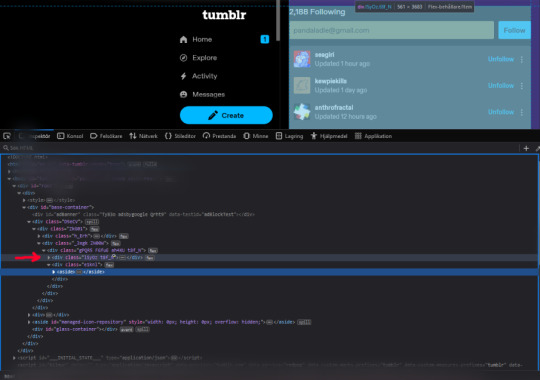
and notice that the very center and only the center where you're followers are shown is lit up, that means inside this line somewhere is your follower list ((its not gonna be pretty)) use the little arrow on the side of this line and click it to expand the underlying code (this is really called nesting i think im not a coder, basically when there an arrow, theres stuff in there)
open the next arrow too (main something something)
keep hovering over the lines within this one and see which one lights up the center and only open that one, next one is "section something something" next class something something
now this might start to look familliar to you if you read all these "data-cell-id=" lines these are all the people you follows usernames,

I'm sure someone who knows how to code would be able to grab this in a neat way and put it in a text document for us, but i dont know how to do that i just know i want it.
so what i do is:
right click the line whose arrow we just opened to be able to see this and select "copy, inner html" this line to be clear

and i make a new notepad document(txt) on my computer, and i paste all that shit in there. and yes it looks like complete nonsense because everything is going everywhere with text you dont need or understand. dont worry about it. you still have all your list of following usernames in there.
now i used vs code(or visual studio code) (its a free program you can just get it if you want use google) and you dont even need to know any coding for this cleaning step. to clean this up, i open the document i created with all this shit in it in vs code and it has the capability to select every instance of a word or symbol or whatever and delete every single one, or replace it. it can also write with multiple cursors at the end of every line of text at the same time. so this way i can get rid of all this nonsense stuff to line up everyones usernames the way i'd like.
you can use google to figure out how to do this, or fuff about in vs code, but selecting a chunk and right clicking and choosing "change all occurrences" is what i used the most.
now if someone who actually codes could… help.. help me please.. dont let anyone else have to use this guide, there has to be a better way. thank you i love you
#tumblr#tumblr guide#tumblr followers#tumblr following#tumblr list#guide#tumblr following list#list of people you follow#please mr google let someone in need see#please mr google let some coder who can help see
2 notes
·
View notes
Text
0 notes
Text
Spatiotemporal Omics Market: Growth Trends, Technologies, and Future Forecast
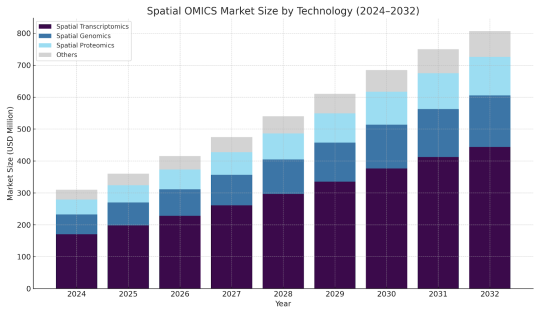
What is spatiotemporal omics?
Spatiotemporal omics is an advanced approach in molecular biology that integrates spatial and temporal dimensions into multi-omics analyses (e.g., genomics, transcriptomics, proteomics, metabolomics). This technique enables the mapping of biomolecular changes within the precise anatomical context of tissues over time, offering unprecedented resolution into how cellular behavior evolves in health and disease. It has transformative potential in areas such as oncology, neuroscience, immunology, and developmental biology, driving innovation in precision medicine and systems biology.
The Spatio OMICS Market is expected to grow at a significant rate due to advancements in sequencing and imaging technologies, and expansion of research and development funding.
Which technologies are driving the spatiotemporal omics market?
Spatial Transcriptomics – Maps gene expression in tissue context
Spatial Proteomics – Visualizes protein distribution
Mass Spectrometry Imaging (MSI) – Detects molecules with spatial precision
Single-Cell RNA Sequencing (scRNA-seq) – Captures temporal changes at cell level
Multiplexed Imaging (e.g., CODEX, MIBI) – Analyzes many biomarkers in tissues
What are the current limitations or challenges in spatiotemporal omics adoption?
High Technology Costs: The advanced instruments and reagents required for spatiotemporal omics are costly, making adoption challenging for many academic and smaller research institutions. This financial barrier limits access despite rising interest in spatial biology.
Complexity of Data Analysis: Spatiotemporal omics generate vast, high-dimensional datasets combining molecular and imaging data. Processing this information demands specialized software, computational infrastructure, and bioinformatics expertise. Without these, deriving actionable insights can be slow and resource-intensive.
Limited Skilled Workforce and Infrastructure: The field requires interdisciplinary skills in molecular biology, spatial imaging, and data science. However, a shortage of trained professionals and inadequate infrastructure in many regions slows down adoption and implementation across research and clinical environments.
To get detailed information on Spatiotemporal OMICS Industry, Click here!
Which regions are investing heavily in spatiotemporal omics research and development?
North America
Europe
Asia-Pacific
Latin America
Who are the leading players in the spatiotemporal omics industry?
10x Genomics
NanoString Technologies
Akoya Biosciences
Bruker Corporation
Vizgen
RareCyte
For a comprehensive analysis, refer to the full report by BIS Research: Spatiotemporal OMICS Market.
End Use Insights
Innovation Strategy: It identifies opportunities for market entry and technology adoption, helping organizations stay ahead of the competition while meeting evolving customer demands.
Growth Strategy: The report outlines targeted growth strategies to optimize market share, enhance brand presence, and drive revenue expansion.
Competitive Strategy: It evaluates key competitors and offers practical guidance for maintaining a competitive edge in a rapidly evolving market.
Conclusion
The market for spatiotemporal omics is expected to increase significantly due to growing applications in clinical and research settings, growing need for precision medicine, and technical advancements. To keep a competitive edge, major competitors in the market are always improving their product offerings, investing in R&D, and inventing. Despite obstacles like exorbitant expenses and intricate data, the amalgamation of artificial intelligence and multi-modal platforms offers significant prospects. Organizations that use these insights can take advantage of development opportunities, overcome obstacles, and set themselves up for long-term success in the ever-changing spatiotemporal omics landscape.
#Spatiotemporal Omics Market#Spatiotemporal Omics Industry#Spatiotemporal Omics Report#health#healthcare
0 notes
Text
The Sky's the Limit: How Solar Drone Panel Inspection is Revolutionizing Renewable Energy
The renewable energy sector is booming, with solar power leading the charge towards a sustainable future. As solar farms proliferate, so does the need for efficient and effective maintenance. Enter solar drone panel inspection, a cutting-edge technology that is transforming how we monitor and maintain these crucial assets. No longer are we confined to laborious, time-consuming, and often hazardous manual inspections. Drones, equipped with advanced cameras and sensors, are taking to the skies, offering unparalleled efficiency, accuracy, and safety.
Historically, inspecting vast solar arrays involved teams of technicians meticulously examining each panel by hand. This process was not only incredibly slow but also fraught with risks, especially on large-scale utility farms or rooftop installations. The sheer scale of modern solar projects makes traditional methods impractical and economically unfeasible for regular maintenance. This is where solar drone panel inspection shines, offering a solution that scales seamlessly with the growing size of solar installations.
The Power of Precision: What Drones See That We Don't
At the heart of effective solar drone panel inspection lies the sophisticated payload these unmanned aerial vehicles (UAVs) carry. High-resolution RGB cameras capture visual data, revealing physical damage like cracks, shattered glass, or accumulation of dirt and debris. This visual evidence is crucial for identifying obvious defects that can impede a panel's performance.
However, the real game-changer is the integration of thermal imaging cameras. These infrared sensors detect subtle temperature variations across the solar panels. Hotspots, often invisible to the naked eye, are critical indicators of underlying issues such as defective cells, shading, bypass diode failures, or faulty electrical connections. By quickly identifying these thermal anomalies, maintenance teams can pinpoint problems early, often before they lead to significant power loss or irreversible damage. This proactive approach is fundamental to maximizing the lifespan and output of solar installations.
Beyond visual and thermal data, advanced solar drone panel inspection systems can also leverage multispectral cameras to assess vegetation encroachment or even detect potential induced degradation (PID) that might not show up as a hotspot initially. The ability to collect such a diverse range of data in a single flight provides a comprehensive health check of the entire solar farm.
Efficiency Unleashed: Time and Cost Savings
The most compelling argument for adopting solar drone panel inspection is the dramatic increase in efficiency and subsequent cost savings. A single drone can survey hundreds of acres in a fraction of the time it would take a ground crew. This speed translates directly into reduced labor costs and minimal disruption to energy production. Imagine inspecting a multi-megawatt solar farm in a matter of hours or days, rather than weeks. This expedited process ensures that issues are detected and addressed much faster, minimizing downtime and maximizing energy output.
Furthermore, the data collected by drones is often geo-tagged and timestamped, allowing for precise localization of defects. This eliminates the guesswork involved in manual inspections, enabling maintenance crews to go directly to the problematic panel, saving valuable time and resources. Automated reporting tools then generate comprehensive reports, detailing the identified anomalies and providing actionable insights for repair and maintenance.
Safety First: Mitigating Risks for Workers
Safety is paramount in any industrial setting, and solar farms are no exception. Manual inspections often involve working at heights, navigating uneven terrain, and operating in potentially hazardous conditions. Solar drone panel inspection significantly reduces these risks by eliminating the need for human personnel to physically access every panel. Drones can inspect hard-to-reach areas, such as rooftop installations or panels on steep inclines, without putting workers in harm's way. This not only protects employees but also reduces liability and insurance costs for solar farm operators.
The shift towards remote, drone-based inspections fosters a safer working environment, allowing human technicians to focus on higher-value tasks, such as diagnosing complex issues and performing targeted repairs, rather than routine, potentially dangerous, inspection work.
The Future is Automated: Predictive Maintenance and AI Integration
The evolution of solar drone panel inspection is deeply intertwined with advancements in artificial intelligence (AI) and machine learning (ML). AI algorithms are increasingly being used to analyze the vast datasets collected by drones, automatically identifying patterns and anomalies that might be missed by human eyes. This includes the ability to differentiate between various types of defects, such as a dirty panel versus a faulty cell.
This automated analysis enables predictive maintenance, where potential issues are identified and addressed before they escalate into major problems. By tracking historical data and analyzing trends, AI can predict when a panel is likely to fail, allowing for proactive intervention and preventing costly unscheduled downtime. The integration of IoT (Internet of Things) further enhances this, allowing drones to communicate seamlessly with other monitoring systems within the solar farm, providing a holistic view of its health and performance.
As the solar industry continues its rapid expansion, solar drone panel inspection is not just a desirable tool, but an indispensable one. It's an investment in efficiency, accuracy, and safety that delivers a significant return on investment, ensuring that solar energy remains a reliable and cost-effective power source for generations to come. The sky is indeed the limit for this transformative technology in the renewable energy landscape.
1 note
·
View note
Text
Excel for Accountants & Payroll: Advanced 2025 Guide

In the fast-paced world of finance and payroll, precision and efficiency are not just advantages—they’re necessities. As we navigate through 2025, one tool continues to dominate the back-end operations of businesses across the globe: Microsoft Excel. Despite newer tools entering the market, Excel remains the gold standard, especially for accounting and payroll professionals who rely on its flexibility and computational power to handle complex financial data.
However, Excel is no longer just about entering numbers into cells. Its advanced capabilities now allow for automation, data visualization, error tracking, and real-time financial analysis. That's exactly what this Advanced Excel Guide 2025 aims to help with—equipping accountants and payroll teams with the modern-day skills to do more in less time, and with greater accuracy.
Why Excel Still Reigns Supreme in Accounting and Payroll
The beauty of Excel lies in its versatility. Whether you’re working for a small business or part of a large enterprise payroll department, Excel can be scaled and tailored to your needs. From setting up employee pay structures and managing timesheets to forecasting budgets and generating financial statements, Excel is the ultimate companion for finance professionals.
With the 2025 updates and integrations, Excel has gone beyond the basics. Now, with powerful features like Power Query, XLOOKUP, dynamic arrays, and pivot charts, accountants can dive deeper into financial insights without relying on multiple software tools. Excel for Payroll isn’t just about calculations anymore—it’s about strategic analysis and decision-making, all happening in one robust spreadsheet.
Mastering Advanced Features in 2025
This year, the focus of many Excel upgrades is about making the tool smarter and more intuitive. For those pursuing an Excel course in 2025, the emphasis is on automation, error reduction, and efficiency. Advanced users are expected to go beyond SUM and VLOOKUP, diving into real-time dashboards, macros, and data modeling.
Understanding tools like Power Pivot is crucial for accountants who need to analyze large datasets quickly. Payroll professionals, meanwhile, benefit from learning IF statements, nested formulas, and conditional formatting, all of which help flag discrepancies, highlight patterns, and maintain consistency in payroll records.
With built-in templates and AI-assisted formula suggestions, Excel is becoming a proactive partner in your financial workflow rather than just a reactive tool. This shift makes learning from an advanced Excel guide all the more essential for staying relevant in the field.
Excel for Accountants: Going Beyond the Ledger
Accounting isn’t just about recording transactions—it’s about interpreting them. Excel gives accountants the power to visualize financial data with tools like charts, sparklines, and scenario managers. Imagine creating a monthly report where every key metric updates automatically when you change a single cell. That’s not just efficient; it’s transformational.
In the Excel guide 2025, special emphasis is placed on data validation, protection, and linked workbooks, which are essential for accountants handling sensitive or collaborative files. Also, auditing tools such as the formula tracer and watch window help reduce the risk of errors and improve overall financial integrity.
Today’s accountant needs to think like a data analyst. With Excel’s robust functionalities, you can forecast sales trends, model financial outcomes, and provide real-time insights to stakeholders—all without switching to different software.
Excel for Payroll: Automating the Repetitive
Payroll processing is one of the most repetitive yet critical functions within any HR or finance team. Mistakes here can lead to compliance issues, dissatisfied employees, and even legal troubles. That’s why modern payroll professionals are leaning heavily on Excel for Payroll automation.
In 2025, payroll experts are expected to understand how to set up dynamic pay scales, automate leave tracking, and generate tax summaries using Excel’s advanced features. Functions like TEXT, DATE, EOMONTH, and NETWORKDAYS are essentials for creating error-free, compliant pay reports.
Using pivot tables, payroll teams can instantly group and filter employee data across departments, track overtime trends, or assess bonus distributions. Excel’s macro recorder can automate the monthly salary sheet generation, saving hours of manual effort.
The Advanced Excel Guide 2025 places a clear focus on these automation techniques—helping professionals cut down on repetitive tasks and spend more time analyzing data for accuracy and trends.
Getting the Most Out of Excel Courses in 2025
If you’re serious about upskilling this year, enrolling in a structured Excel course is a smart move. But not all courses are created equal. The best programs in 2025 go beyond basic functions, offering real-world case studies that mirror the day-to-day work of accountants and payroll professionals.
Look for courses that include hands-on training in financial reporting, data modeling, and payroll scheduling. Learning how to build an interactive dashboard or automate monthly close processes can be a career-changer. Not only will it make your job easier, but it will also add tremendous value to your organization.
Today’s employers expect accountants and payroll managers to be self-sufficient with data tools. With the right Excel guide 2025, you can confidently step into that expectation and even go a step beyond.
Real-World Application of Advanced Excel Skills
Think of Excel not as a spreadsheet but as a business engine. Imagine you’re working in a midsize company and your monthly payroll file includes data for 500 employees. With the right formulas, you can calculate taxes, deductions, and net pay automatically. With pivot charts, you can provide HR with insights on salary distribution. And with data validation, you ensure no one enters invalid values or dates.
Similarly, in accounting, you can use Excel to build cash flow projections or break-even analyses using just a few linked sheets. Want to track financial KPIs or set up alerts when expenses exceed a threshold? Excel makes it possible—all with a bit of setup and understanding of its deeper features.
This is the power of Excel when it’s in the hands of a trained professional.
Why This Guide Matters in 2025 and Beyond
The need for accuracy, speed, and automation in finance roles has never been greater. As regulations evolve and business demands grow, accountants and payroll specialists can’t afford to stick with outdated methods. The Advanced Excel Guide 2025 is more than just a manual—it’s a strategic resource for professionals who want to elevate their roles and future-proof their careers.
By learning how to leverage the full capabilities of Excel, you not only enhance your individual productivity but also contribute to a more agile and responsive organization. Whether you’re generating payroll summaries, auditing financial statements, or analyzing expense patterns, Excel has the tools—you just need to know how to use them.
Conclusion: Step Into the Future of Finance with Excel
Excel isn’t just a spreadsheet; it’s your financial Swiss Army knife. With 2025’s features and advanced tools, it’s time to move beyond basics and embrace the power of smart spreadsheets. For accountants and payroll professionals alike, mastering Excel is no longer optional—it’s a competitive edge.
So, whether you’re self-taught, seeking formal training, or simply looking to refresh your skills, the Excel guide 2025 is your roadmap to a more productive, insightful, and efficient financial workflow.
Don’t just use Excel. Master it—and make 2025 your most productive year yet.
0 notes
Text
SAS Tutorial for Data Visualization: Creating Charts and Graphs That Tell a Story
In today's data-driven world, the ability to visualize data effectively is crucial for analysts and decision-makers. SAS offers robust tools for creating insightful visualizations that can uncover hidden patterns and trends. This SAS tutorial provides a step-by-step guide to crafting compelling charts and graphs using SAS, enabling you to tell a meaningful story with your data.
Understanding the Importance of Data Visualization
Data visualization transforms raw data into graphical representations, making complex information more accessible and understandable. Effective visualizations can highlight key insights, facilitate comparisons, and support data-driven decisions. In SAS, various procedures and tools are available to create a wide range of visualizations, from simple bar charts to complex heat maps.
Getting Started with SAS Visualization Tools
SAS provides several procedures for data visualization:
PROC SGPLOT: Ideal for creating single-cell graphs like bar charts, line plots, and scatter plots.
PROC SGPANEL: Useful for generating multi-cell graphs, allowing comparisons across different categories.
PROC SGSCATTER: Designed for creating scatter plot matrices to explore relationships between multiple variables.
PROC SGPIE: Enables the creation of pie and donut charts.
PROC SGMAP: Facilitates the rendering of maps with overlaid plots, useful for geographical data analysis.
These procedures are part of the ODS (Output Delivery System) Graphics, which provide a flexible and powerful framework for generating high-quality graphics.
Creating Basic Charts with PROC SGPLOT
Let's start with a simple bar chart using PROC SGPLOT. Suppose you have a dataset containing sales figures for different regions:
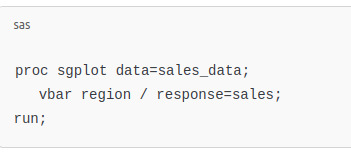
This code generates a vertical bar chart displaying sales by region. The vbar statement specifies the categorical variable (region), and the response option indicates the numerical variable (sales) to be plotted.
Enhancing Visualizations with Customizations
SAS allows extensive customization of charts to improve clarity and aesthetics:
Titles and Labels: Use title and label statements to add descriptive titles and axis labels.
Colors and Styles: Customize colors, line styles, and markers to differentiate data points.
Legends: Add legends to identify different groups or categories within the chart.
Annotations: Incorporate annotations to highlight specific data points or trends.
For example, to add a title and customize the color of bars:

Creating Multi-Panel Charts with PROC SGPANEL
When comparing data across multiple categories, PROC SGPANEL is invaluable. It allows the creation of panel charts, where each panel represents a subset of the data:
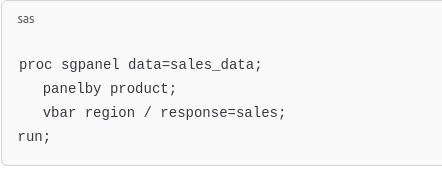
This code generates a series of bar charts, one for each product, facilitating easy comparison across regions.
Visualizing Relationships with PROC SGSCATTER
To explore relationships between numerical variables, scatter plots are effective. PROC SGSCATTER can create scatter plot matrices:
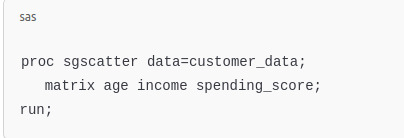
This produces a matrix of scatter plots, allowing you to observe pairwise relationships among age, income, and spending_score.
youtube
Creating Pie Charts with PROC SGPIE
Pie charts are useful for showing proportions. PROC SGPIE simplifies their creation:

This code generates a pie chart illustrating each company's market share.
Best Practices for Effective Data Visualization
To create impactful visualizations:
Know Your Audience: Tailor the complexity and type of visualization to your audience's needs.
Choose the Right Chart Type: Select chart types that best represent the data and highlight key insights.
Simplify: Avoid clutter by focusing on essential information and removing unnecessary elements.
Use Consistent Scales: Ensure axes are scaled appropriately to allow accurate comparisons.
Highlight Key Data: Use color or annotations to draw attention to significant data points or trends.
Conclusion
Mastering data visualization in SAS empowers you to convey complex data insights clearly and effectively. By leveraging procedures like PROC SGPLOT, PROC SGPANEL, and others, you can create a variety of charts and graphs that not only represent data accurately but also tell a compelling story. As you become more proficient, you'll be able to craft visualizations that drive informed decisions and communicate findings with impact.
#sas tutorial#sas tutorial for beginners#sas programming#data analyst#data analytics#Data Visualization#Youtube
0 notes
Text
Drones for Solar Panel Inspection: Enhancing Efficiency and Accuracy

As solar energy continues to grow as a key source of renewable power, maintaining the performance of solar panels is more important than ever. Faulty or dirty panels can significantly reduce energy output, leading to increased costs and reduced return on investment. Traditional inspection methods are time-consuming, labor-intensive, and sometimes risky. That’s where drones come in—offering a faster, safer, and more accurate way to inspect solar panels, especially in large-scale installations.
Why Inspect Solar Panels?
Regular inspections help ensure that solar panels are operating efficiently and safely. Issues such as cracks, hotspots, soiling, shading, and electrical faults can go unnoticed but cause significant drops in performance. If these problems are not detected early, they can escalate into more serious damage or system failure.
In large solar farms or commercial rooftop installations, manually inspecting thousands of panels can be both time-consuming and prone to human error. Drones offer a modern alternative, providing precise data in a fraction of the time.
How Drone Solar Inspections Work
Drones used for solar panel inspection are typically equipped with two types of cameras:
High-resolution RGB cameras capture detailed images of the panels to spot visible defects like dirt, cracks, and physical damage.
Thermal (infrared) cameras detect heat signatures, making it possible to identify hotspots, inactive cells, or wiring issues that aren't visible to the naked eye.
The drone flies over the solar array using a pre-programmed flight path, capturing images and thermal data. This information is then processed with software that uses artificial intelligence or machine learning to identify and categorize issues. The result is a detailed report pinpointing exactly where problems exist, allowing technicians to perform targeted maintenance.
Benefits of Using Drones
Speed and Efficiency: Drones can inspect thousands of panels in a single flight, covering vast areas in minutes rather than hours or days.
Improved Safety: There's no need for workers to climb rooftops or walk across hot panels, reducing the risk of injury and panel damage.
Higher Accuracy: Advanced sensors and AI-powered analytics ensure that even minor issues are detected with precision.
Cost Savings: Fewer personnel are required, inspections are quicker, and issues are identified early—leading to lower maintenance and operational costs.
Scalability: Drones are suitable for all installation sizes, from small commercial rooftops to sprawling utility-scale solar farms.
Applications Across the Solar Industry
Commissioning Inspections: Verifying the quality of newly installed systems before they go live.
Preventive Maintenance: Routine checks to ensure systems are performing at optimal levels.
Warranty and Insurance Claims: Providing visual and thermal documentation of panel condition.
Post-Storm Assessments: Quickly identifying damage after extreme weather events.
Conclusion
Drones have transformed how solar panel inspections are conducted. With their ability to deliver high-quality data quickly, safely, and affordably, they are an invaluable tool for solar asset managers, maintenance teams, and energy providers. As drone and imaging technologies continue to advance, their role in maintaining solar infrastructure will only become more critical.
0 notes
Text
Inside the Development Cycle: Editors, Runtimes, and Notebooks
In the evolving world of data science, knowing algorithms and models is only part of the story. To truly become proficient, it’s equally important to understand the development cycle that supports data science projects from start to finish. This includes using the right editors, managing efficient runtimes, and working with interactive notebooks—each of which plays a vital role in shaping the outcome of any data-driven solution.
If you’re beginning your journey into this exciting field, enrolling in a structured and comprehensive data science course in Hyderabad can give you both theoretical knowledge and practical experience with these essential tools.
What Is the Development Cycle in Data Science?
The data science development cycle is a structured workflow that guides the process of turning raw data into actionable insights. It typically includes:
Data Collection & Preprocessing
Exploratory Data Analysis (EDA)
Model Building & Evaluation
Deployment & Monitoring
Throughout these stages, data scientists rely on various tools to write code, visualise data, test algorithms, and deploy solutions. Understanding the development environments—specifically editors, runtimes, and notebooks—can make this process more streamlined and efficient.
Code Editors: Writing the Blueprint
A code editor is where much of the data science magic begins. Editors are software environments where developers and data scientists write and manage their code. These tools help format code, highlight syntax, and even provide autocomplete features to speed up development.
Popular Editors in Data Science:
VS Code (Visual Studio Code): Lightweight, customisable, and supports multiple programming languages.
PyCharm: Feature-rich editor tailored for Python, which is widely used in data science.
Sublime Text: Fast and flexible, good for quick scripting or data wrangling tasks.
In most data science classes, learners start by practising in basic editors before moving on to integrated environments that combine editing with runtime and visualisation features.
Runtimes: Where Code Comes to Life
A runtime is the engine that executes your code. It's the environment where your script is interpreted or compiled and where it interacts with data and produces results. Choosing the right runtime environment is crucial for performance, compatibility, and scalability.
Types of Runtimes:
Local Runtime: Code runs directly on your computer. Good for development and testing, but limited by hardware.
Cloud-Based Runtime: Services like Google Colab or AWS SageMaker provide powerful cloud runtimes, which are ideal for large datasets and complex models.
Containerised Runtimes: Using Docker or Kubernetes, these environments are portable and scalable, making them popular in enterprise settings.
In a professional data science course in Hyderabad, students often gain experience working with both local and cloud runtimes. This prepares them for real-world scenarios, where switching between environments is common.
Notebooks: The Interactive Canvas
Perhaps the most iconic tool in a data scientist's toolkit is the notebook interface. Notebooks like Jupyter and Google Colab allow users to combine live code, visualisations, and explanatory text in a single document. This format is ideal for storytelling, collaboration, and experimentation.
Why Notebooks Matter:
Interactivity: You can run code in segments (cells), making it easy to test and modify individual parts of a script.
Visualisation: Direct integration with libraries like Matplotlib and Seaborn enables real-time plotting and analysis.
Documentation: Notebooks support markdown, making it simple to annotate your work and explain results clearly.
These features make notebooks indispensable in both academic learning and professional development. Many data science courses now revolve around notebook-based assignments, allowing students to document and share their learning process effectively.
Putting It All Together
When working on a data science project, you’ll often move fluidly between these tools:
Start in an editor to set up your script or function.
Run your code in a suitable runtime—either local for small tasks or cloud-based for heavier jobs.
Switch to notebooks for analysis, visualisation, and sharing results with stakeholders or collaborators.
Understanding this workflow is just as important as mastering Python syntax or machine learning libraries. In fact, many hiring managers look for candidates who can not only build models but also present them effectively and manage their development environments efficiently.
Why Choose a Data Science Course in Hyderabad?
Hyderabad has quickly emerged as a tech hub in India, offering a vibrant ecosystem for aspiring data professionals. Opting for data science courses in Hyderabad provides several advantages:
Industry Exposure: Access to companies and startups using cutting-edge technologies.
Expert Faculty: Learn from instructors with real-world experience.
Career Support: Resume building, mock interviews, and job placement assistance.
Modern Curriculum: Courses that include the latest tools like Jupyter notebooks, cloud runtimes, and modern editors.
Such programs help bridge the gap between classroom learning and real-world application, equipping students with practical skills that employers truly value.
Conclusion
The success of any data science project depends not only on the strength of your algorithms but also on the tools you use to develop, test, and present your work. Understanding the role of editors, runtimes, and notebooks in the development cycle is essential for efficient and effective problem-solving.
Whether you’re an aspiring data scientist or a professional looking to upskill, the right training environment can make a big difference. Structured data science classes can provide the guidance, practice, and support you need to master these tools and become job-ready.
Data Science, Data Analyst and Business Analyst Course in Hyderabad
Address: 8th Floor, Quadrant-2, Cyber Towers, Phase 2, HITEC City, Hyderabad, Telangana 500081
Ph: 09513258911
0 notes